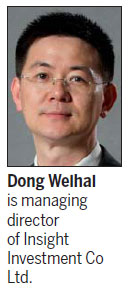
Urbanization drive

Besides economic growth and capital investment, there is also a strong demand for property due to rapid urbanization in China.
According to a study conducted by the Chinese Academy of Social Sciences, China's urbanization is expected to reach 75 percent by about 2040, which means that more than 14 million people will move to cities every year over the next 30 years.
"The real estate sector will have a lot of opportunities for development during the next 30 years of further urbanziation," says Chen Huai, director of the Institute of Urban-Rural Development of China.
Dong from Insight Investment says that the Chinese realty market is quite comprehensive but complicated and full of opportunities and challenges. "It is definitely not a dying market or a bursting bubble."
Challenges ahead
After decades of high-speed development, the property sector is now transforming to a higher-level market-oriented economy. This process will lead to structural adjustments in all Chinese cities as well as further market liberalization, says Chen from the Institute of Urban-Rural Development of China.
"The Chinese realty industry entered the third level of market development with property rights, but skipped the process of marketing production factors including land and capital," Chen says, adding that a more liberalized realty market can exert a bigger influence.
According to Chen, most developers in China are concerned about the current controls on the sector. Of the 297 major Chinese cities, only about 40 have restrictions on property purchase, or in other words 17 percent of the total market.
"Developers hoping to make big profits from the third or fourth home buys by wealthy families in smaller Chinese cities are unrealistic," he says, adding that the second and third decades of Chinese urbanization should focus more on developing the second and third-tier cities. "As long as China does not have the urban development structure of mega, medium and small cities, the housing price bubbles in the major cities will not be solved without government restrictions."
Other than the 14 million people migrating to Chinese cities every year, the growth of the middle class is another force that is of immense cheer to the property sector.
Audrey Kaplan, senior portfolio manager at Federated Investors Inc, a US-based financial services company, said in a recent article that the upper-mid to high-end level of the Chinese housing market, where demand is soaring along with the Chinese middle class, is projected to add 250 million households over the next eight years. "That is equivalent to 750 million people, or roughly 2.5 times larger than the entire US population. And these households don't just want homes. They want cars, clothes and other goodies too," she says.
"Residential development should not only focus on the quantity but also on the quality of supply," says Dong from Insight Investment. "Developers and local governments should pay more attention on how to improve the overall living environment with more public schools, hospitals, public transport and other facilities in local communities."
Special Coverage
 Steelmakers bend as realty wanes
Steelmakers bend as realty wanes
 Making the experience count
Making the experience count
 Reality check for real estate
Reality check for real estate
 Testing the property reform limits
Testing the property reform limits